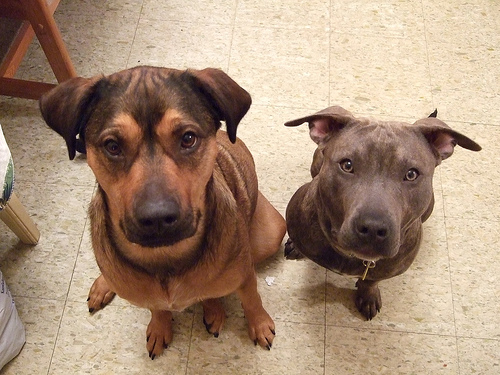 This is a guest post by Sarah Danielson who writes for Pitbulls, where you can find information on training, health, diet, and food for the popular and often misunderstood breed.
This is a guest post by Sarah Danielson who writes for Pitbulls, where you can find information on training, health, diet, and food for the popular and often misunderstood breed.
Traveling can be a pretty big hassle these days, even if you only have to worry about yourself. But throw a pet in the mix and suddenly you have a whole other world of headaches to worry about, not the least of which is keeping your animal companion comfortable and calm for the duration of this often stressful experience.
- Prepare, Prepare, Prepare! – The best way to know how your pet will react to travel is to try it out on a smaller scale ahead of time. Try taking an overnight trip to a place that is about an hour away to see how your furry friend deals with extended time in a carrier and staying in a strange location. Or take a short plane ride to visit friends and return quickly. Knowing how your animal reacts to various types of travel could make a difference in the mode of transportation you choose for longer trips (or if you opt to take your pet along at all). And acclimation to trips couldn’t hurt, either, especially if you travel frequently.
- Get Comfortable With The Carrier – You should have your pet using the carrier from the time you bring him home so that when you put him into it, he won’t automatically become agitated (as when you only use it for trips to the vet). Try using it as a bed by putting him in each night to sleep, and consider taking him on short rides in the car often.
 Bring Toys And Treats – If your dog or cat is preoccupied with a favorite toy, he may not even notice that you’ve plopped him down in one of many travel accommodations. And treats are always a good way to distract your furry friend and let him know that everything is okay.
Bring Toys And Treats – If your dog or cat is preoccupied with a favorite toy, he may not even notice that you’ve plopped him down in one of many travel accommodations. And treats are always a good way to distract your furry friend and let him know that everything is okay.- Meet Their Needs – Just because you aren’t plagued by thirst and the need to use the bathroom doesn’t mean your pet is in the same state. If you’re traveling by car, make sure you take frequent stops to let your pet stretch his legs, see the scenery, and heed the call of nature. For plane travel, just make sure he has the option to use the great outdoors at the last possible minute before you embark.
- Explore Alternatives – Unfortunately, even the best laid plans may not keep your pet from going a bit berserk during travel. In the event that you simply can’t keep him calm, you may have to consider giving him a prescription to calm or knock him out (this is generally preferred for plane travel). If you are worried about the side effects of such drugs, then maybe he’ll be better off with a pet-sitter while you’re away.
Some pets are good travelers that are as at-ease in a car or carrier as they are at home. But the majority of animals become excited, agitated, and even frightened when you remove them from their element and force them to travel great distances. Whether you’re going on the road or planning a trip by plane or train, you need to ensure that you do everything in your power to make the experience easy on your pet.
Thank you very much for the guest post Sarah. Readers, as a side-note, you should be careful if you’re considering the 5th option, as many airlines don’t allow drugged animals to fly. You can read more from Sarah on Pitbulls.org.
[photos by: This Year’s Love (two dogs looking at camera), PetteriO (small dog playing with ball)]








{ 2 comments… read them below or add one }
So we just came back from a 6 month road trip with our dogs. We drove through 24 states, covering 15,000 miles. The best ways to keep a dog calm during a car trip isn’t mentioned above. #1 – Exercise. A LONG walk before you set out on your trip lets our boys fall asleep as soon we start driving. #2 – Mileage. You simply can’t travel as far with a dog in your car – so don’t try. Pets need to get out and exercise more during the day. During our road trip, we rarely traveled more than 300 miles in a day.
I can’t agree more – with all the traveling I do with my pug, exercise is the best calming solution. It’s good for the owner too 🙂